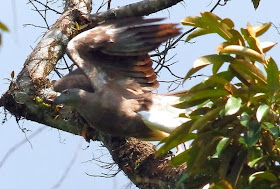The Grey-headed Fish Eagle
It is a bird of prey
and specialist fish eater which hunts over lakes, lagoons and large rivers.
Like all eagles, it is in the family Accipitridae. Grey-headed Fish Eagle
breeds in southern Asia from India and Sri Lanka to south east Asia and the
Philippines. It is a forest bird which builds a stick nest in a tree near water
and lays two to four eggs.
Grey-headed Fish Eagle is a largish stocky raptor at about 70–75 cm in length.
Adults have dark brown wings and back, a grey head and reddish brown breast.
The lower belly, thighs and tail are white with a black terminal band. Sexes
are similar, but young birds have a pale buff head, underparts and underwing,
all with darker streaking.
Sad to say in Peninsular Malaysia (previously common, now uncommon and sparse,
perhaps 40 pairs remaining), east Malaysia, Singapore (scarce), Brunei
(scarce), and the Greater Sundas and Sulawesi, Indonesia (widely distributed
but uncommon in Sumatra and Borneo, and now very rare in Java). Although widely
distributed, the species is local and declining in most parts of its range
through loss of forested wetlands. However, historical and even recent records
are difficult to interpret, in South-East Asia at least, due to identification
difficulties between this species and Lesser Fish Eagle.

















